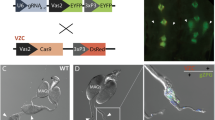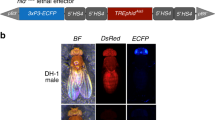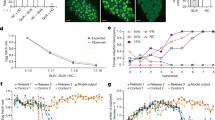Abstract
RESISTANCE and deleterious environmental side-effects have limited the use of insecticides in insect control programmes, and researchers have become increasingly aware of the potential of population control by genetic manipulation. In pioneering experiments, screw-worm fly eradication was accomplished by the release of sterile males into natural populations, and wide use of this method was anticipated1. Serious drawbacks, however, have often limited the successful utilization of this approach2. Males are usually sterilized by the induction of dominant lethal mutations in a high proportion of sperm and spermatids by treatment with ionizing radiation or chemical mutagens. In some species the treated males do not compete successfully with males from the natural population for mating partners; in others the sterile males may not trigger a monogamous response in mated females, or male fertility is regained with time.
This is a preview of subscription content, access via your institution
Access options
Subscribe to this journal
Receive 51 print issues and online access
$199.00 per year
only $3.90 per issue
Buy this article
- Purchase on Springer Link
- Instant access to full article PDF
Prices may be subject to local taxes which are calculated during checkout
Similar content being viewed by others
References
Knipling, E. F., in Genetics of Insect Vectors of Disease (edit. by Wright, J. W., and Pal, R.), 587 (Elsevier, Amsterdam, 1967).
LaChance, L. E., Schmidt, C. H., and Bushland, R. C., in Pest Control (edit. by Kilgore, W. W., and Doutt, R. L.), 147 (Academic Press, New York, 1967).
Knipling, E. F., Laven, H., Craig, G. B., Pal, R., Kitzmiller, J. B., Smith, C. N., and Brown, A. W. A., Bull. Wld Hlth Org., 38, 421 (1968).
Lorimer, N., Hallinan, E., and Rai, K. S., J. Hered., 63, 159 (1972).
Foster, G. G., Whitten, M. J., Prout, T., and Gill, R., Science, 176, 875 (1972).
Lindsley, D. L., and Lifschytz, E., in Edinburgh Symposium on the Genetics of the Spermatozoon (edit. by Beatty, R. A., and Gluecksohn-Waelsch, S.), 203 (Bogtrykkeriet Forum, Copenhagen, 1972).
Smith, R. H., in Sterility Principle for Insect Control or Eradication, 453 (Intern. Atomic Energy Agency, Vienna, 1971).
Author information
Authors and Affiliations
Rights and permissions
About this article
Cite this article
DENELL, R. Use of Male Sterilization Mutations for Insect Control Programmes. Nature 242, 274–275 (1973). https://doi.org/10.1038/242274a0
Received:
Revised:
Issue Date:
DOI: https://doi.org/10.1038/242274a0
This article is cited by
Comments
By submitting a comment you agree to abide by our Terms and Community Guidelines. If you find something abusive or that does not comply with our terms or guidelines please flag it as inappropriate.



